There are many amazing birds in South Dakota–about 430 species, to be precise! We wrote about 26 of those birds in our South Dakota Bird Guide, including cardinals, woodpeckers, jays, hummingbirds, swallows, meadowlarks, and more. Now it’s time to move on to sparrows!
Sparrows are little brown birds that can be difficult to identify, but delightful to see. Some kinds of sparrows are so commonplace that they get overlooked by those who enjoy birdwatching and spotting.
This list should help you think about sparrows in new ways–and learn to watch for them in the Mount Rushmore State!
Before we can talk about the 24 kinds of sparrows that consistently live in or visit South Dakota, let’s make sure we all know what, exactly, a sparrow is in the first place. Not every little brown bird is a sparrow, but most sparrows are little brown birds!
What Makes a Sparrow a Sparrow?
According to the Spruce, “sparrow” refers to a wide range of relatively small, mostly drab brown birds, which birders often refer to as “LBJs” or “little brown jobs” due to their notorious difficulty in identification.
While many of these birds have the term “sparrow” in their common names, other types of sparrows include buntings, towhees, and juncos.
Sparrows are all Passerines (songbirds) and share the following characteristics:
- They are small in size, measuring between 4-8 inches.
- They have predominantly brown plumage, ideal for blending into their surroundings.
- Most have a short, stocky, cone-shaped bill.
How Many Sparrows Are in South Dakota?
There are 24 different sparrows that can be found in South Dakota. Some of them pass through the state during their migration between breeding and winter territories, while others reside here year-round or only during the summer or winter seasons.
Regardless of your location within the state, you will have numerous opportunities to observe and listen to sparrows.
Here’s what our list includes:
- Size (length, weight, and wingspan)
- Scientific name
- Visual description
- Info on fascinating behaviors
- When and where they can be found in South Dakota
Although identifying various types of sparrows can pose a challenge even for experienced birders, we hope that these descriptions and pictures will assist you in distinguishing one bird from another.
Our list is categorized into sparrows that are present in South Dakota during the summer, winter, only during migration, and those that reside all year round.
Let’s get started!
Sparrows in South Dakota All Year
There is only one kind of sparrow that can be found in South Dakota all year round: the House Sparrow:
House Sparrow
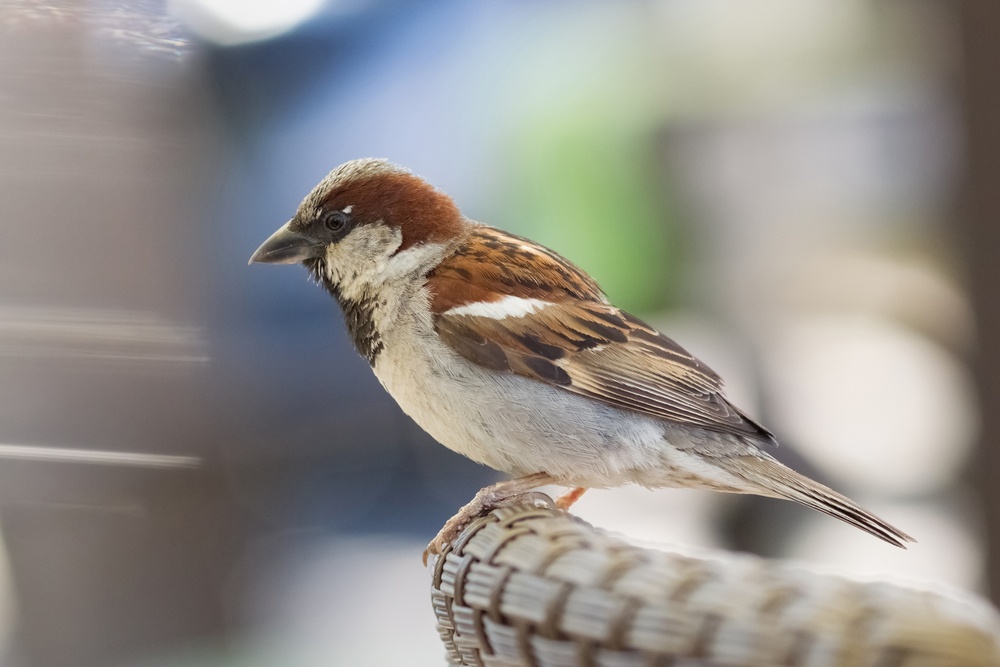
- Passer domesticus
- Order: Passeriformes
- Family: Passeridae
- Length: 5-6 inches (14-16 cm)
- Weight: 1-1.4 ounces (28-40 grams)
- Wingspan: 7-9 inches (19-23 cm)
The House Sparrow is a small, stout bird thick bill. The male has a gray crown, black bib, and chestnut-colored back. The female and juvenile have a more subdued plumage with brown and gray tones, while both sexes have a buff-colored belly.
House Sparrows are highly adaptable and can be found in various habitats, especially in urban areas. They are commonly seen around human structures such as buildings, barns, and feeders.
In South Dakota, House Sparrows can be found throughout the state, including cities, towns, and agricultural areas. They are often found near residential areas where they take advantage of food sources like spilled grains, bird feeders, and discarded food.
House Sparrows are an invasive species, and they cause problems for native birds in many towns, cities, and other habitats. They are extremely aggressive and territorial and will even kill birds that they perceive to be a threat.
They also exhibit opportunistic feeding behaviors, meaning that whatever they can find, they will eat! This includes seeds, grains, and insects, as well as food scraps and crumbs from the people they live near.
House Sparrows are social birds and often gather in large flocks, particularly during the non-breeding season. Despite being invasive, House Sparrows have become one of the most widespread and abundant bird species on the continent.
Sparrows in South Dakota in the Summer
Summer in South Dakota is when you are most likely to see plenty of sparrows. There are 14 different varieties of sparrows in South Dakota just for the summer. You may also see House Sparrows in the state during the summer months.
The 14 sparrows in South Dakota during the summer are as follows:
Baird’s Sparrow
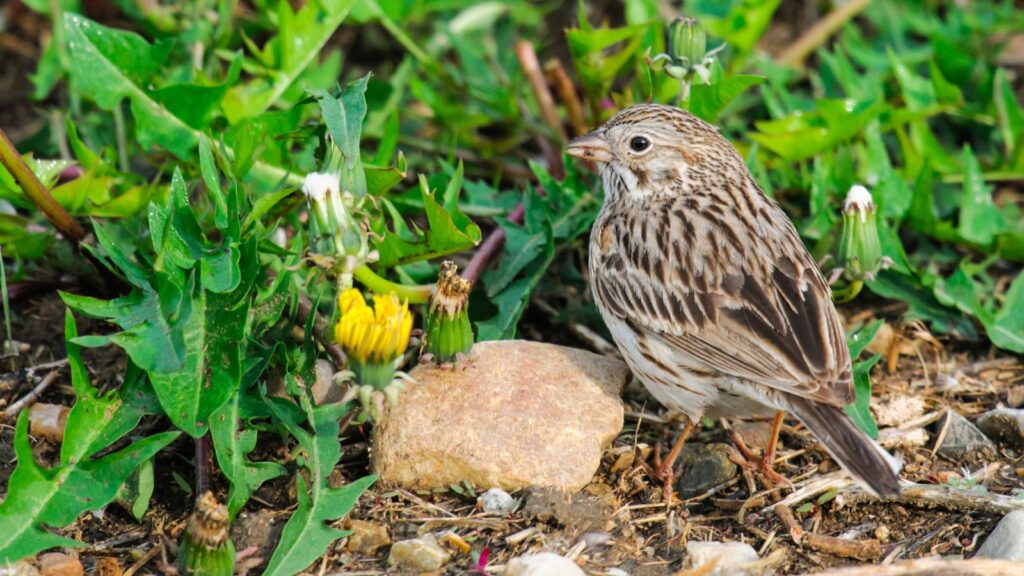
- Centronyx bairdii
- Order: Passeriformes
- Family: Passerellidae
- Length: 5-6 inches (13-15 cm)
- Weight: 0.6-0.8 ounces (17-23 grams)
- Wingspan: 7-8 inches (18-20 cm)
The Baird’s Sparrow is a shy, elusive sparrow with a small breeding range. It has a streaked back with a combination of brown, buff, and blackish feathers. The underparts are pale with faint streaking. Its tail is short, whereas its bill is longer than other sparrows.
Baird’s Sparrow can be found in the northern Great Plains during the breeding season, including parts of South Dakota. It prefers habitats with tall grasses, particularly in areas with mixed grass and shrublands.
They are usually found in native prairies and grasslands where they rely on the protection provided by dense vegetation. Their secretive nature and well-camouflaged plumage make them challenging to spot, as they tend to stay hidden among the grasses.
Baird’s Sparrow has a distinctive song that sounds like a series of buzzy, insect-like notes. During the breeding season, males perch atop grass stems or shrubs and sing to establish territories and attract mates.
They primarily feed on seeds, grasses, and insects, foraging on the ground and occasionally in low vegetation. Baird’s Sparrows undertake long migrations, spending the winter in the southern United States and northern Mexico before returning to their breeding grounds in the Great Plains.
Brewer’s Sparrow
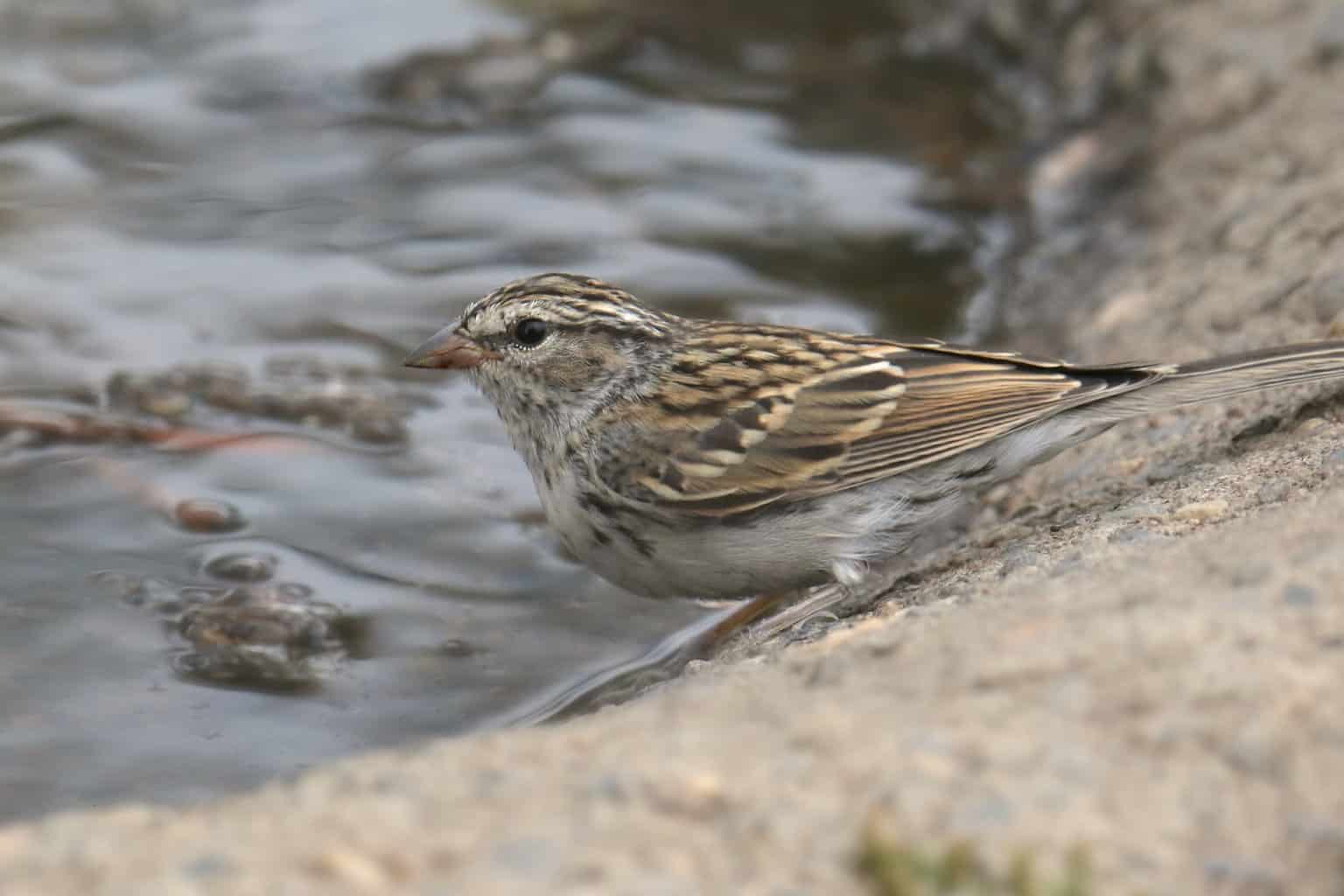
- Spizella breweri
- Order: Passeriformes
- Family: Passerellidae
- Length: 4-5 inches (11-13 cm)
- Weight: 0.4-0.5 ounces (12-15 grams)
- Wingspan: 6-7 inches (15-18 cm)
The Brewer’s Sparrow is North America’s smallest sparrow. It has a short, notched tail, a brownish-gray body, and some streaking on its back. Its belly is pale gray, while its facial markings include a pale eye stripe. Compared to other sparrows, the Brewer’s Sparrow is quite plain. A real “Little Brown Job” if there ever was one!
Brewer’s Sparrows are found in both arid and semi-arid habitats throughout South Dakota, such as sagebrush flats, desert scrub, and grasslands. They are well-adapted to these dry environments and can survive with just a tiny amount of water.
They forage on the ground for seeds, insects, and berries, and they often seek shelter and build their nests in shrubs or low vegetation.
The Brewer’s Sparrow has a pleasant, musical song that is often described as a series of thin, high-pitched notes. During the South Dakota summer, you may hear males singing to protect their territory. They are short-distance migrants who breed in the Badlands along the state’s western border.
Chipping Sparrow
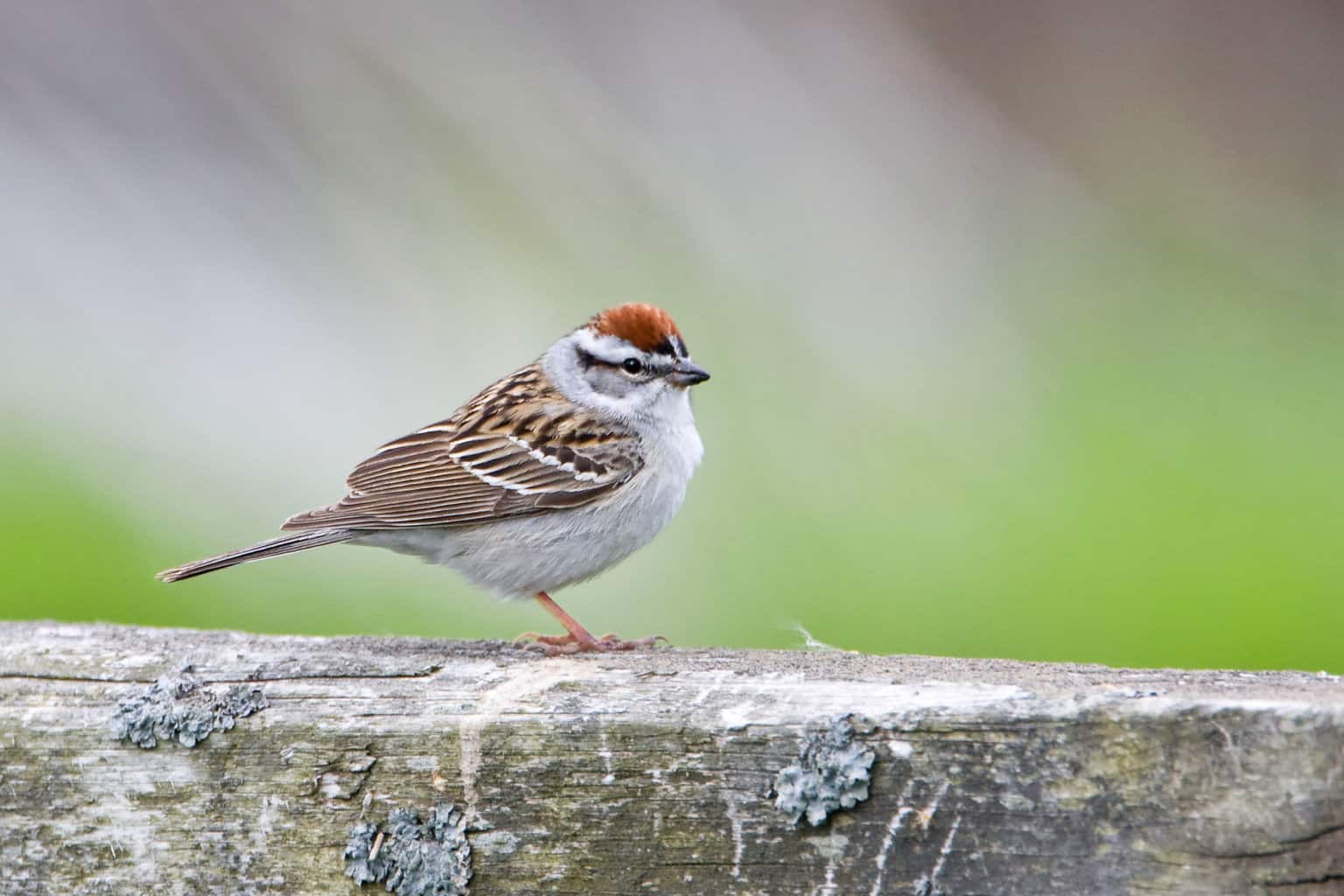
- Spizella passerina
- Order: Passeriformes
- Family: Passerellidae
- Length: 4.7-5.9 inches (12-15 cm)
- Weight: 0.4-0.5 ounces (11-14 grams)
- Wingspan: 7-9 inches (18-23 cm)
The cute little Chipping Sparrow is a small, slender bird with a relatively long tail and a sharp bill. It has a crisp, clean plumage with a brownish crown, a gray face, and a rusty-red cap. The back is streaked with brown and black, and the underparts are pale gray with a touch of buff on the breast.
Look for that signature red cap to identify the Chipping Sparrow, but don’t mix him up with the similarly capped American Tree Sparrow or Field Sparrow, both of which are found in South Dakota. That said, the American Tree Sparrow is only present in the winter, so you can easily differentiate between these two.
Chipping Sparrows are widespread throughout all of South Dakota during the summer. They inhabit a variety of open habitats, including woodlands, forest edges, parks, gardens, and residential areas.
These sparrows are particularly fond of coniferous forests and mixed forests with ample shrubbery. You are most likely to see them hopping along the ground, foraging for food. Their diet includes seeds and berries during the winter and insects during the summer.
Chipping Sparrows are known for their distinct and repetitive song, often described as a dry trill or a series of rapidly delivered chips. That is, of course, where they get their name. You are likely to see Chipping Sparrows at your birdfeeder.
Clay-colored Sparrow
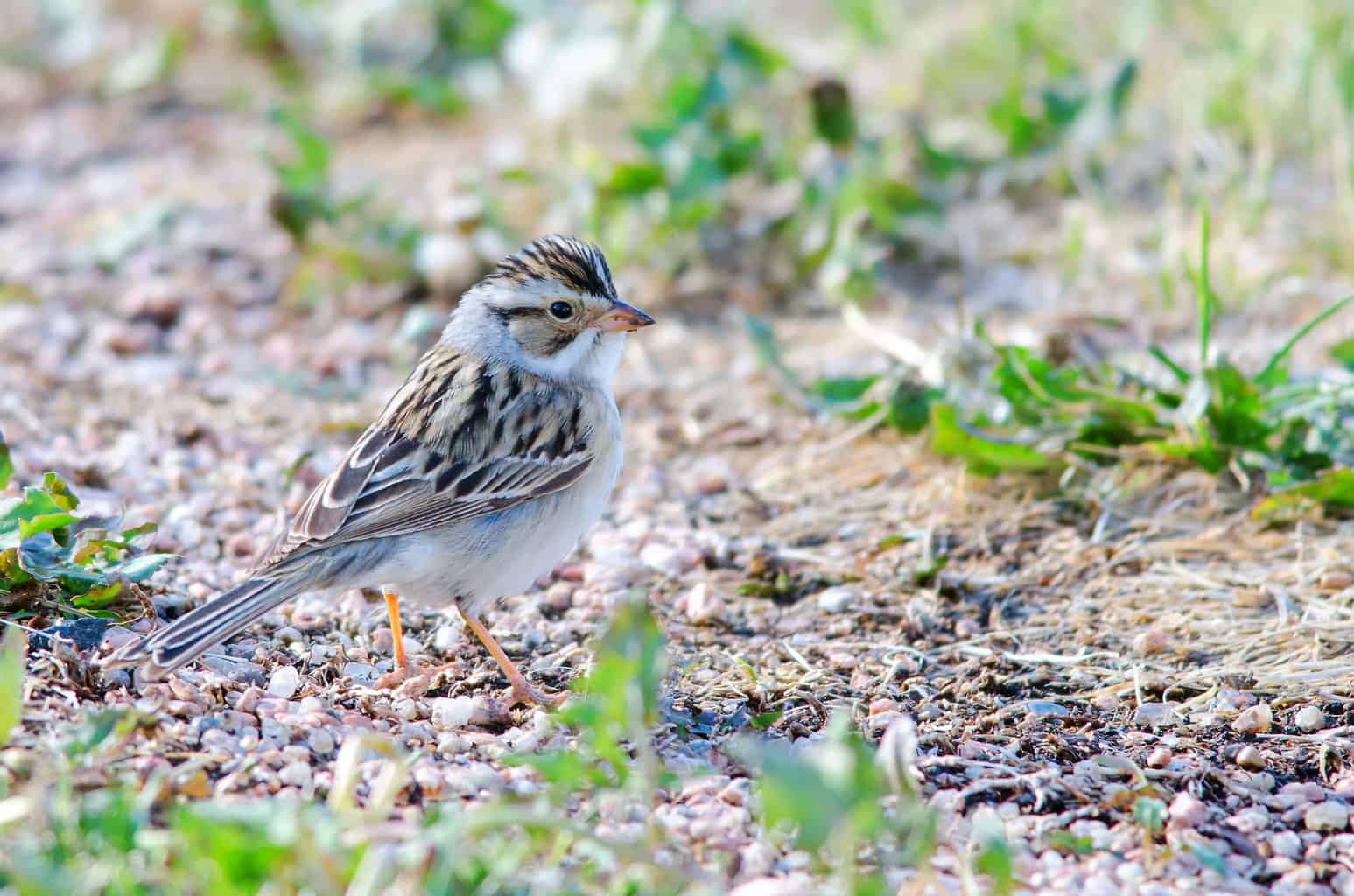
- Spizella pallida
- Order: Passeriformes
- Family: Passerellidae
- Length: 4.7-5.9 inches (12-15 cm)
- Weight: 0.4-0.6 ounces (11-17 grams)
- Wingspan: 7-8 inches (18-20 cm)
The Clay-colored Sparrow is dainty with a round body and a short tail. It has a subtle and delicate plumage with overall pale grayish-brown tones. The head is adorned with a dark, streaky crown, and its chest tends to be plain pale gray.
During the summer, some Clay-colored Sparrows live in the northeastern corner of South Dakota. Otherwise, they are generally migratory visitors in most of the state. They favor grasslands, prairies, and areas with plenty of scattered shrubs. They also thrive in tall grasses where they are offered plenty of protection.
They are known for hopping backward and forward as they forage for food, which includes insects during the summer and seeds and berries in the winter.
The Clay-colored Sparrow has a beautiful, melodic song. The male sings a series of notes that are clear and distinctively patterned, which you’re likely to hear in the summer.
Field Sparrow
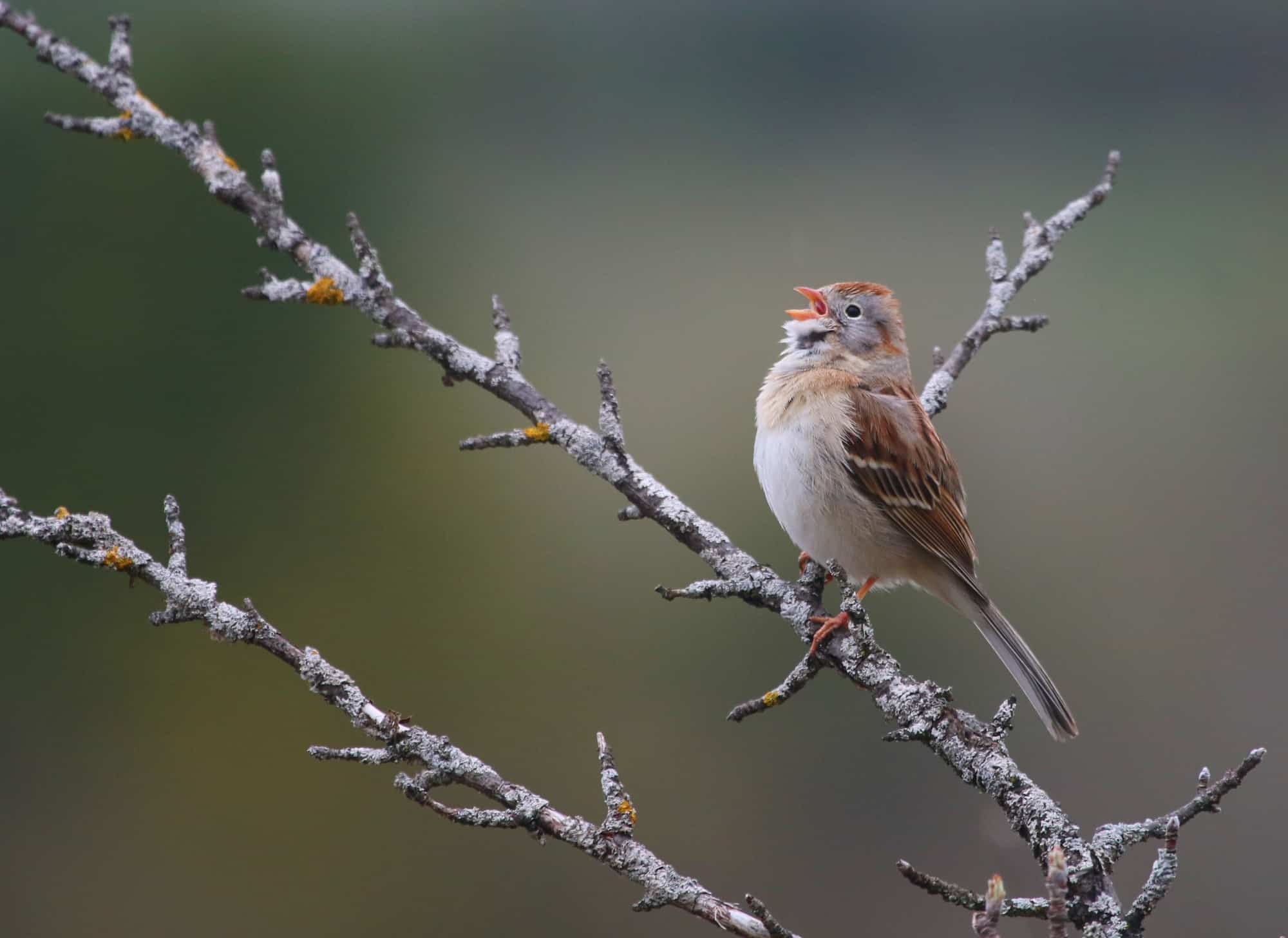
- Spizella pusilla
- Order: Passeriformes
- Family: Passerellidae
- Length: 5-6 inches (13-15 cm)
- Weight: 0.4-0.6 ounces (12-17 grams)
- Wingspan: 7-8 inches (18-20 cm)
The Field Sparrow is quite charming. It has a rounded body, long notched tail, and a warm, reddish-brown crown. Its face is gray, and its back is rusty-brown.
The Field Sparrow has a light breast with dark streaking, a round body, and a long tail. It has a warm, earthy plumage with a reddish-brown crown, a gray face, and a rusty-brown back. The breast is light buff with dark streaks that converge into a central spot, giving it a distinctive appearance.
Field Sparrows are widespread throughout most of South Dakota, although there are some areas where they don’t tend to congregate. They are summer-only birds in South Dakota, but they are year-round residents in most Eastern US states.
Field Sparrows live in grasslands, meadows, and agricultural fields, especially if there is a mix of short grasses, scattered shrubs, and short vegetation. Their nests are cup-shaped and are found in low vegetation, such as grasses and shrubs.
Grasshopper Sparrow
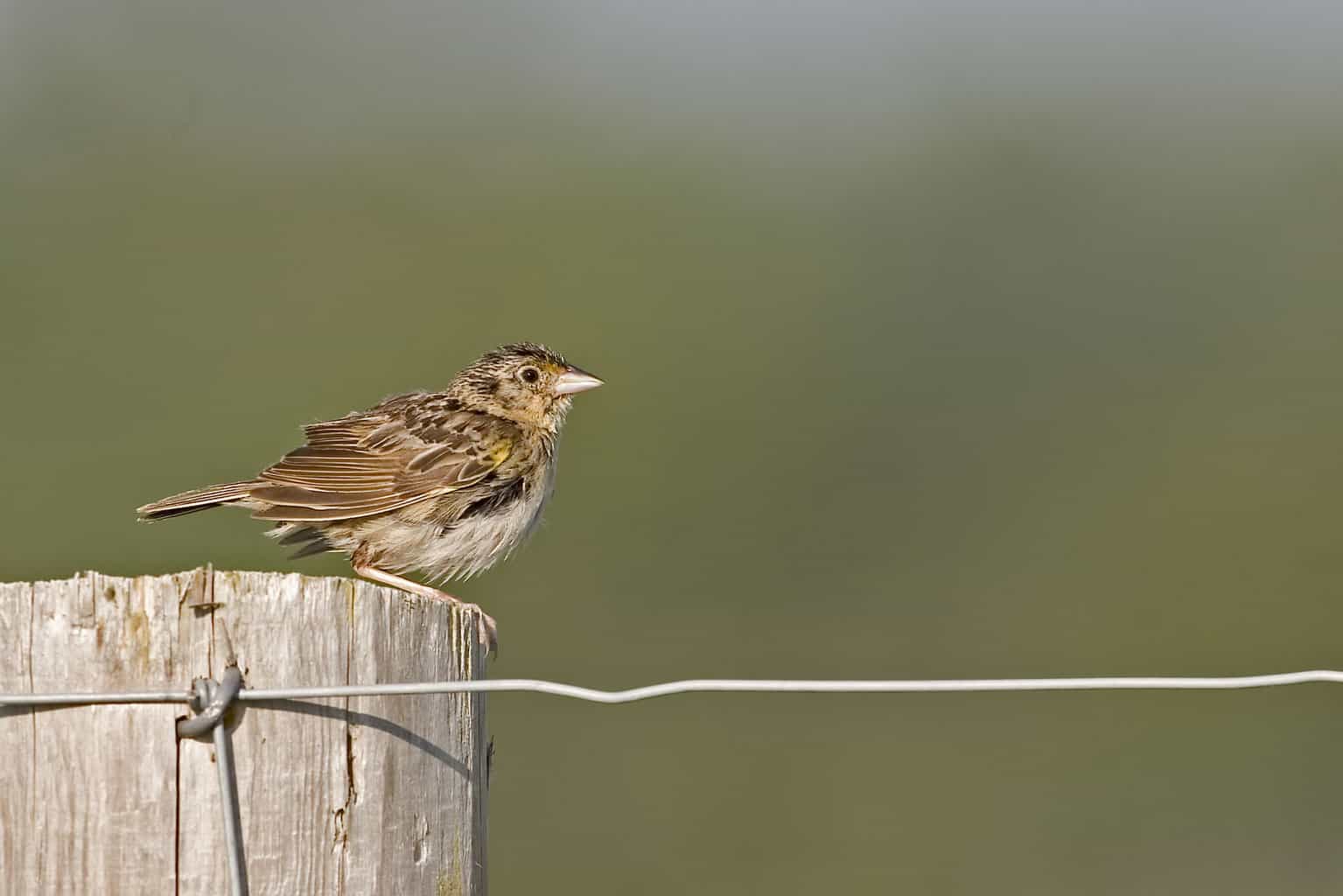
- Ammodramus savannarum
- Order: Passeriformes
- Family: Passerellidae
- Length: 4.3-5.1 inches (11-13 cm)
- Weight: 0.3-0.4 ounces (9-12 grams)
- Wingspan: 7-8 inches (18-20 cm)
The Grasshopper Sparrow has a long bill, short tail, and round body. It gets its name from the fact that it sounds a lot like a grasshopper when it sings – although it does, in fact, eat grasshoppers, too!
The Grasshopper Sparrow has a combination of buff, brown, and black markings. It has a pale stripe down the middle of its crown, as well as a distinctive eye ring. Its buff breast is finely streaked, and it has a pale gray belly.
Grasshopper Sparrows are found across South Dakota all summer long, in the state’s grasslands, prairies, and shrubby fields. They spend most of their time foraging for food on the ground, but males will also perch to sing during the summer.
Grasshopper Sparrows build their nests directly on the ground but hide them among tall grasses and vegetation. Therefore, you are more likely to hear this elusive, shy bird than you are to see it.
Henslow’s Sparrow
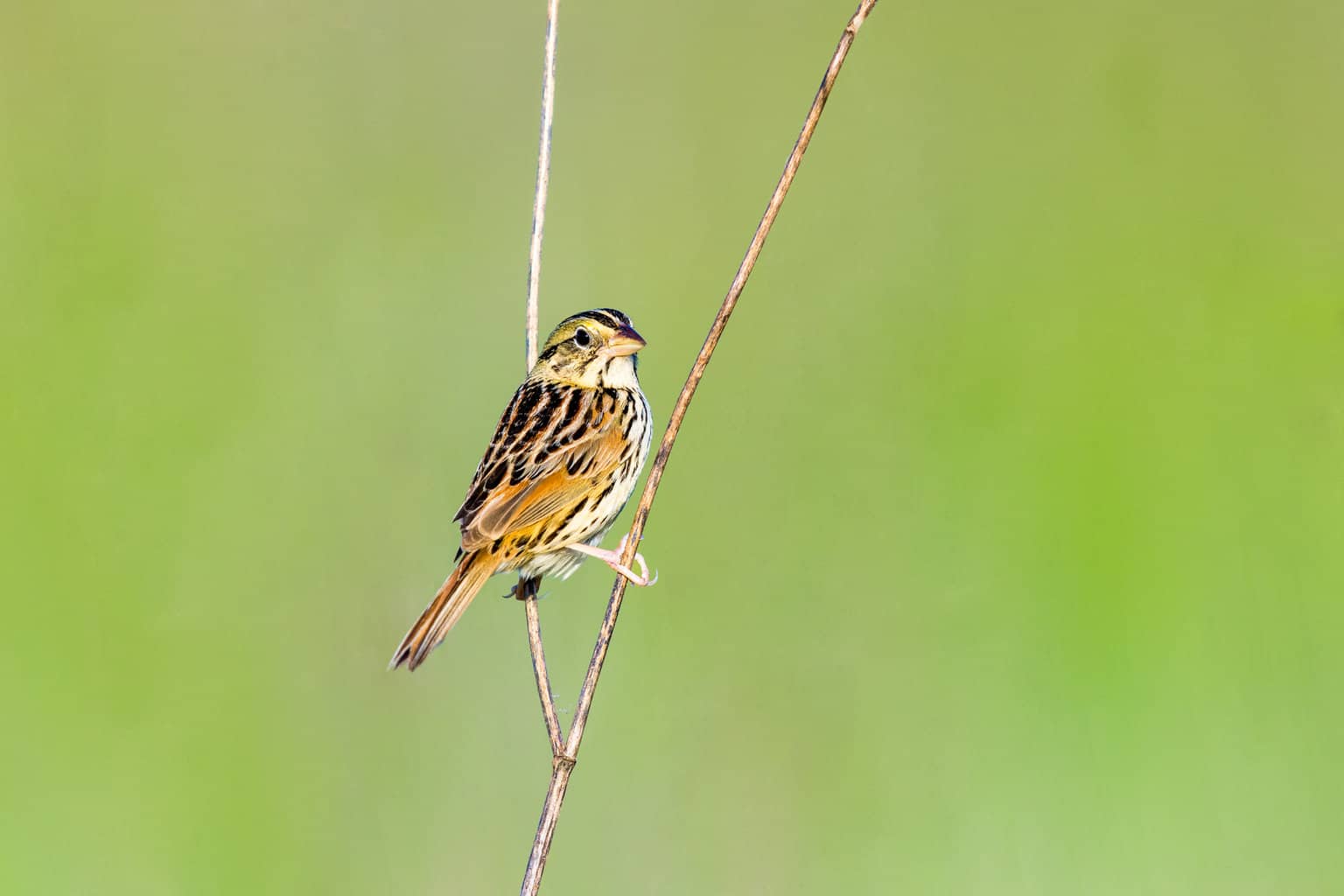
- Centronyx henslowii
- Order: Passeriformes
- Family: Passerellidae
- Length: 4.7-5.1 inches (12-13 cm)
- Weight: 0.4-0.5 ounces (12-15 grams)
- Wingspan: 7-8 inches (18-20 cm)
The Henslow’s Sparrow has a yellow wash of color that makes it stand out from other sparrows. Unfortunately, it is still excellent at camouflage, and it tends to stay hidden all day long. They can be a challenge to spot!
Their feathers are brown, olive green, and gray. Henslow’s Sparrows have a flat crown, pale face, and pale mustache stripe. Their breast is buff and faintly streaked, while the belly is pale.
Henslow’s Sparrows don’t consistently breed in South Dakota, but they have an established breeding population in nearby Iowa. This means that some of these nomadic sparrows usually end up in South Dakota each year.
If you end up seeing one, it will likely be in wet grassland, meadow, or prairie. The more sedges and grasses there are, there better.
Lark Bunting
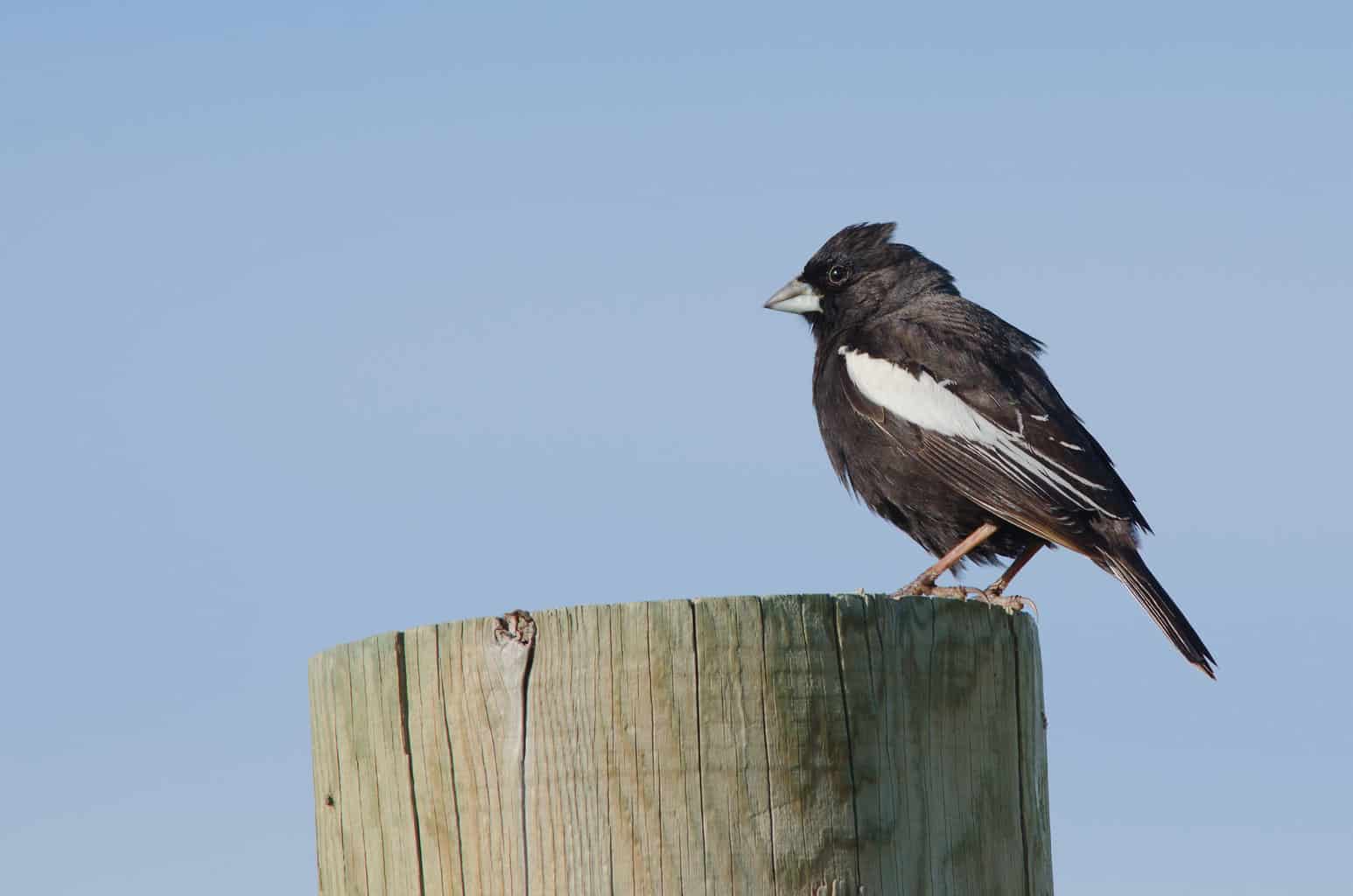
- Calamospiza melanocorys
- Order: Passeriformes
- Family: Passerellidae
- Length: 5.5-6.3 inches (14-16 cm)
- Weight: 1-1.2 ounces (28-34 grams)
- Wingspan: 10-11 inches (25-28 cm)
When it comes to the Lark Bunting, breeding-season males are very easy to recognize. They are almost all black, but they have white patches on their wings.
However, females, juveniles, and non-breeding males are a bit trickier to identify. They are all much more subdued, with gray-brown feathers and some streaking on their backs.
They are unlikely to be found in the eastern part of the state, along the border with Iowa and Minnesota, but they are common summer residents of the rest of the state. They are found in grasslands, prairies, and shrubby fields with lots of sagebrush.
They are very acrobatic in their mating display. Watch for them diving and showing off like aerialists.
Lark Buntings have become a symbol of the North American Prairie.
Lark Sparrow

- Chondestes grammacus
- Order: Passeriformes
- Family: Passerellidae
- Length: 5.9-6.7 inches (15-17 cm)
- Weight: 0.9-1.1 ounces (25-31 grams)
- Wingspan: 9-10 inches (23-25 cm)
The coloring of a Lark Sparrow’s body, including its wings, back, and belly, are quite typical of other sparrows: light gray with dark brown streaking. However, its face is very distinctive! It has a black and white striped crown and big, broad, chestnut-brown patches on its cheeks.
Lark Sparrows are breeding-season residents of most of South Dakota, although they avoid the northeastern corner of the state. They are grassland and prairie dwellers who are very adaptable and can make almost any habitat work for them.
Their diet includes insects in the summer and berries and seeds in the winter. They will also eat small fruits.
Lark Sparrows offer a complex, variating song that includes a series of musical phrases, trills, and buzzes.
They are medium-distance migrants who spend the winter in the southern United States and Mexico but will flock together during the non-breeding season and forage in large groups. During the breeding season, they are more solitary and more protective of their habitats.
Savannah Sparrow

- Passerculus sandwichensis
- Order: Passeriformes
- Family: Passerellidae
- Length: 4.7-6.3 inches (12-16 cm)
- Weight: 0.4-0.7 ounces (12-20 grams)
- Wingspan: 7.9-9.1 inches (20-23 cm)
The slender little Savannah Sparrow has a lot of regional variation, meaning its appearance in one region is slightly different from its appearance in another. It usually has a streaky brown back, pale gray breast, and yellow eyebrow. Sometimes, Savannah Sparrows will have a reddish-brown cap or a yellowish face.
They are widespread throughout all of South Dakota during the summer, most frequently in grasslands, meadows, and marshes. Because they can adapt easily to new environments, they may also be found on dunes, in agricultural fields, and in coastal habitats.
Although they spend a lot of time foraging on the ground, Savannah Sparrows will often perch a few feet above the ground in shrubs and scan the ground for insects, which they consume or carry back to their young.
Savannah Sparrows are one of the most widespread sparrows in North America, and there are abundant numbers of them in South Dakota and beyond.
Song Sparrow

- Melospiza melodia
- Order: Passeriformes
- Family: Passerellidae
- Length: 5.5-7.1 inches (14-18 cm)
- Weight: 0.9-1.3 ounces (26-37 grams)
- Wingspan: 7.9-9.8 inches (20-25 cm)
The Song Sparrow is one of the most populous sparrows in North America. It is a medium-sized sparrow with a plump body and a long, rounded tail. It has a rich brown plumage with dark streaks on the sides and back. It also has a creamy or grayish-white breast that is streaked in bold brown. They are recognizable from their grayish-brown mask and pale stripe above the eye.
Song Sparrows are summer residents of South Dakota’s Glacial Lakes and Prairies region in the northeast. In the southeast, they are year-round residents. They are found in the winter in the southern Black Hills and Badlands. Generally, Song Sparrows are non-migratory, but there is some short-distance migration that occurs in South Dakota.
They live in many different habitats throughout South Dakota, including the state’s marshes, wetlands, riparian areas (riverbanks), and shrubby fields and plains. They are commonly sighted in backyard gardens and public parks.
The Song Sparrow gets its name from the fact that it has several complex songs made up of phrases, trills, buzzes, and more.
As monogamous birds, Song Sparrows build their nests in dense vegetation, either close to the ground or just barely above it.
Spotted Towhee
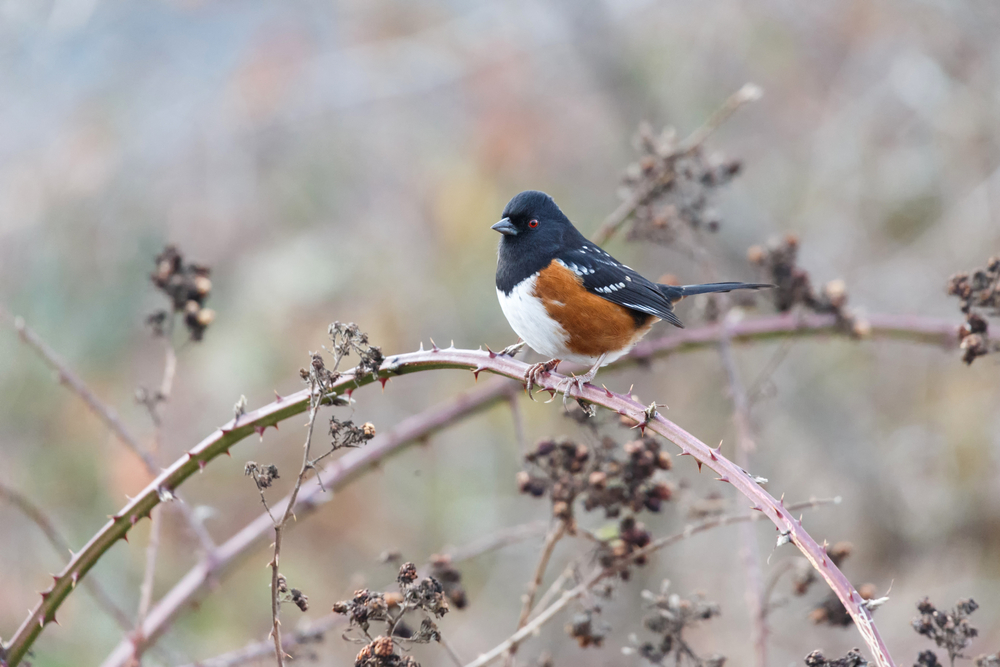
- Pipilo maculatus
- Order: Passeriformes
- Family: Passerellidae
- Length: 7-8.5 inches (18-22 cm)
- Weight: 1.4-1.8 ounces (40-51 grams)
- Wingspan: 8.7-11 inches (22-28 cm)
Spotted Towhees and Eastern Towhees aren’t usually found in the same state, but there is some overlap in South Dakota. Spotted Towhees are much more common in the state, but you will find Eastern Towhees in the list of birds that visit South Dakota while migrating.
The Spotted Towhee is a medium-sized sparrow with a chunky body and a long, rounded tail. The male has a striking appearance with a black head, back, and tail, which contrasts with his red belly. He has white spots on his wings and tail. Females are more muted in their coloring, and they are brownish-gray instead of dark red.
Spotted Towhees are generally only found in the western quarter of South Dakota, basically in the Badlands. They are ground-dwellers who can be found in shrubby areas, thickets, and along the edges of the woods. They eat insects and spiders during the summer, and then they switch to a winter diet of seeds and berries.
Spotted Towhees make a “chewink” sound as a call, which gives them the nickname of Chewink. They tend to be non-migratory, but the ones in South Dakota tend to move into the American Southwest for the winter. Many Towhees in that region will stay put year-round.
Swamp Sparrow

- Melospiza georgiana
- Order: Passeriformes
- Family: Passerellidae
- Length: 4.7-5.5 inches (12-14 cm)
- Weight: 0.6-0.8 ounces (18-23 grams)
- Wingspan: 6.7-7.5 inches (17-19 cm)
The stocky Swamp Sparrow has a short, rounded tail and fairly recognizable plumage: reddish-brown upperparts, grayish breast, sides with dark streaks, and a white throat and belly. They have a reddish-brown crow.
Swamp Sparrows are found in the summertime in the Glacial Lakes and Prairies region of South Dakota, usually in wetlands like swamps, ponds, streams, and marshes. You may still see them in the rest of the state, but only as they migrate. They tend to stay in thick vegetation, including cattails and bullrushes, where there is plenty of protection from predators and the elements.
Their diet includes insects, spiders, and seeds.
Swamp Sparrows are long-distance migrants who travel to the Midwest, American Southeast, and Mexico for the winter.
Vesper Sparrow
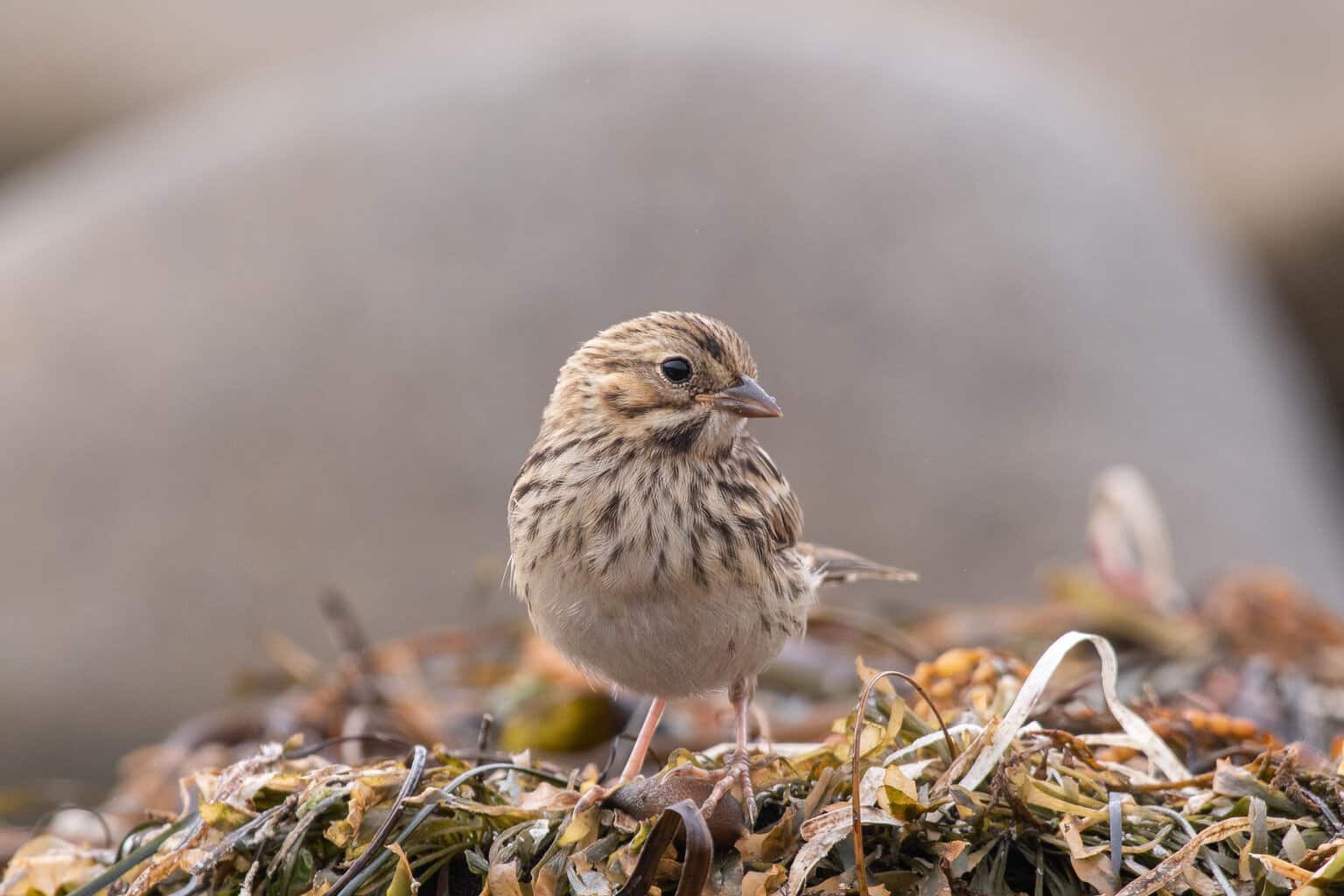
- Pooecetes gramineus
- Order: Passeriformes
- Family: Passerellidae
- Length: 5.5-6.7 inches (14-17 cm)
- Weight: 0.9-1.1 ounces (25-31 grams)
- Wingspan: 9.4-11 inches (24-28 cm)
The Vesper Sparrow is a delicate, medium-sized sparrow with a lightly streaked pale breast, a streaky back, and a pale breast. On its head, the Vesper Sparrow has a gray-brown crown and a white eyering.
Vesper Sparrows live in open grasslands, prairies, and fields. They are widespread throughout South Dakota during their summer breeding season. Typically, they’ll be spotted on the ground, foraging for seeds, grasses, and insects.
Vesper Sparrows get their name from their lovely evening song, which occurs at the same time as the Vesper prayer service held by some Christian traditions. This pretty song is quite lovely, too.
Vesper Sparrows are partial migrants who travel in small groups at night.
Sparrows in South Dakota in Winter
There are only two kinds of sparrows that travel to South Dakota for the winter: the American Tree Sparrow and the Dark-Eyed Junco. Of course, you’ll also see the year-round House Sparrows in South Dakota during the winter.
American Tree Sparrow
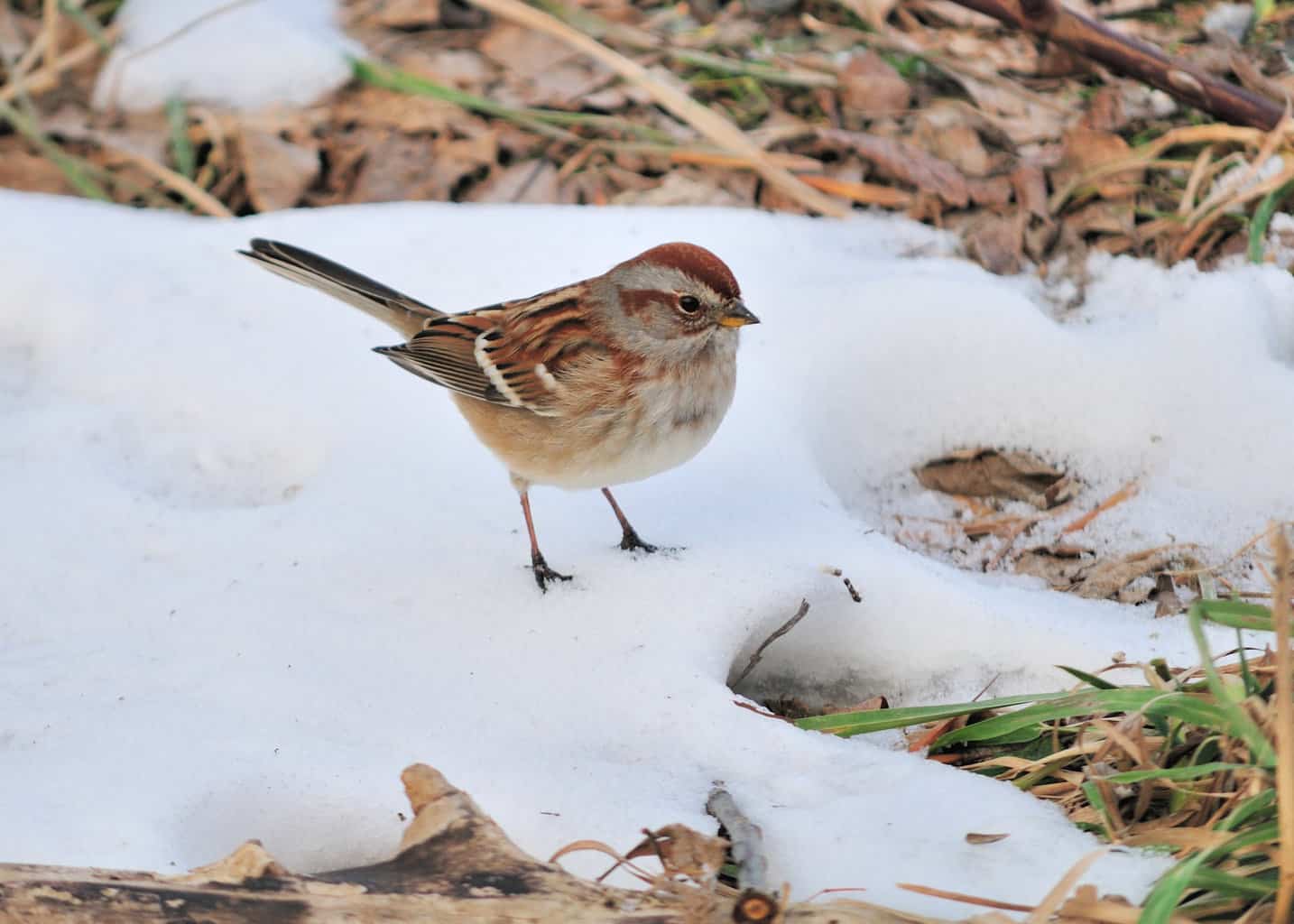
- Spizelloides arborea
- Order: Passeriformes
- Family: Passerellidae
- Length: 5.5-6.3 inches (14-16 cm)
- Weight: 0.8-1.1 ounces (23-31 grams)
- Wingspan: 7.9-9.4 inches (20-24 cm)
The American Tree Sparrow is a pretty little sparrow with a plump, rounded body and a long tail. Its reddish-brown cap sets it apart from other sparrows, but the easiest way to recognize it may be the black spot in the middle of its chest. The America Tree Sparrow has a brown back that is streaked with black and reddish-brown feathers.
The American Tree Sparrow breeds in the tundra of Canada and spends the winter spread across most of the US. They prefer habitats like thickets and hedgerows with lots of protective coverage and are ground foragers who are often seen in small flocks.
American Tree Sparrows are among the most cold-hardy sparrows in the world.
Dark-eyed Junco

- Junco hyemalis
- Order: Passeriformes
- Family: Passerellidae
- Length: 5.1-6.3 inches (13-16 cm)
- Weight: 0.6-1 ounce (18-28 grams)
- Wingspan: 7.9-9.8 inches (20-25 cm)
This plump little bird, the Dark-Eyed Junco, is associated so closely with winter weather that it is frequently called the snowbird. Dark-Eyed Juncos are round with a dark gray head and neck and a light gray belly.
They are year-round residents of most of the American Northwest, and so there may be a few individuals that live year-round along the western edge of South Dakota.
For the most part, however, these are winter-only birds in the state. They are comfortable in a variety of habitats, including forests, woodlands, brushy areas, and suburban neighborhoods, and are commonly found in backyard feeders.
Dark-Eyed Juncos tend to travel and live in flocks, too, and have a trilling song that is sometimes described as “tinkling” or “ringing.”
Sparrows in South Dakota During Migration
The last of our sparrows in South Dakota aren’t summer or winter residents, but rather, they migrate through the state in the spring and/or fall.
These sparrows are the Eastern Towhee, the Fox Sparrow, the Harris’s Sparrow, the LeConte’s Sparrow, the Lincoln’s Sparrow, the Nelson’s Sparrow, the White-Crowned Sparrow, and the White-Throated Sparrow.
Eastern Towhee

- Pipilo erythrophthalmus
- Order: Passeriformes
- Family: Passerellidae
- Length: 7-9 inches (18-23 cm)
- Weight: 1.1-1.8 ounces (32-52 grams)
- Wingspan: 7.9-11.8 inches (20-30 cm)
Towhees are a bit bigger than other sparrows. The Eastern Towhee is a medium-sized member of the Passerellidae family. The male Eastern Towhee has a black back, rufous sides, and a white belly. Females are similarly patterned, but their coloring is more subtle. Their red eyes are striking, too.
Eastern Towhees are only found in the eastern half of the US. Why is South Dakota on the list, then? Well, they migrate through the far eastern edge of the state every spring and fall.
They may be found in woodlands, on forest edges, and in thickets and fields. They almost always stay protected by the shrubs and undergrowth, but you can listen for their distinct vocalizations.
Their song sounds like the phrase “drink-your-tea,” and their calling is a loud “chewink.” Sometimes, the Eastern Towhee is called the Chewink.
Fox’s Sparrow

- Passerella iliaca
- Order: Passeriformes
- Family: Passerellidae
- Length: 5.9-7.5 inches (15-19 cm)
- Weight: 0.8-1.3 ounces (23-37 grams)
- Wingspan: 8.7-10.6 inches (22-27 cm)
Fox Sparrows are medium-sized. There is a lot of regional variation in their appearance, but all of them have some reddish-brown on their bodies. The amount of streaking can range from a few light reddish-brown streaks to being almost entirely red in color.
Look for the distinctive features on its face: rusty-red crown, gray face, and dark eyeliner. The Fox Sparrow’s bill is slightly curved, which makes it different from many other sparrows who have straight, pointy bills.
Fox Sparrows are migratory visitors to much of South Dakota, although you generally won’t see them in the northwestern Black Hills and Badlands. They are excellent at hiding–so much so that they can be a challenge to track down! They are quite secretive in their behavior.
Fox Sparrows have a beautiful song that sounds flute-like. Unfortunately, they usually save this song for their breeding season, so you’re less likely to hear it in South Dakota as they migrate.
Harris’s Sparrow
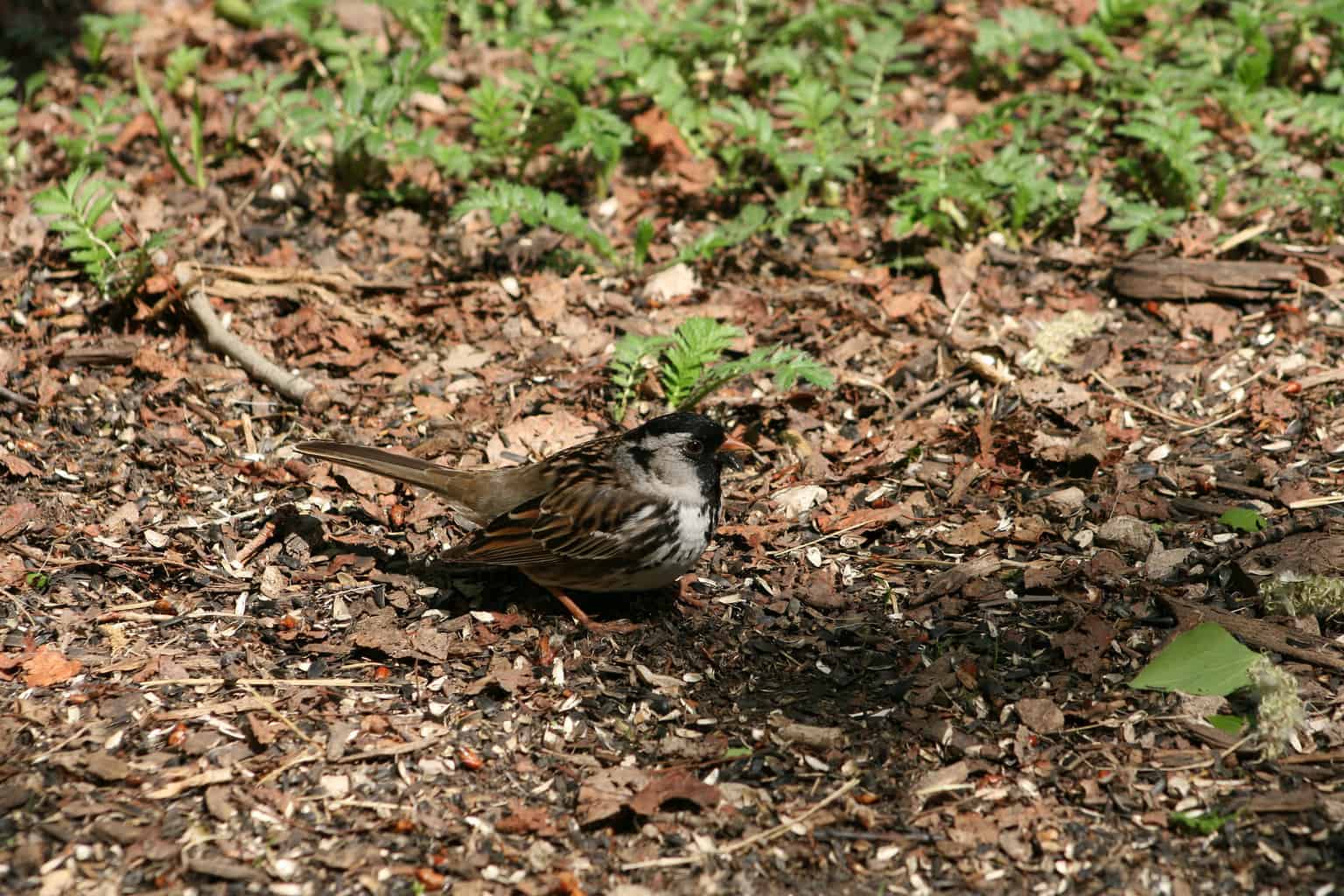
- Zonotrichia querula
- Order: Passeriformes
- Family: Passerellidae
- Length: 6.3-7.5 inches (16-19 cm)
- Weight: 1.2-1.6 ounces (34-45 grams)
- Wingspan: 9.8-11.8 inches (25-30 cm)
Aside from Towhees, Harris’s Sparrow is the largest sparrow in North America. It has a stocky frame and rounded head, with a distinctive black crown that extends down the sides of its face, which gives it the appearance of having a hood.
The Harris’s Sparrow has a pinkish-colored bill, yellowish legs, and whiteish upper parts. They are the only sparrow that breeds exclusively in Canada–nowhere else in the world! In fact, they are often symbolically associated with the Canadian wilderness.
They migrate through South Dakota, stopping in open woodlands and shrubby areas that are near water. They are ground foragers who eat seeds, berries, and, if necessary, insects. They are happy to intermingle with other species of sparrows.
LeConte’s Sparrow
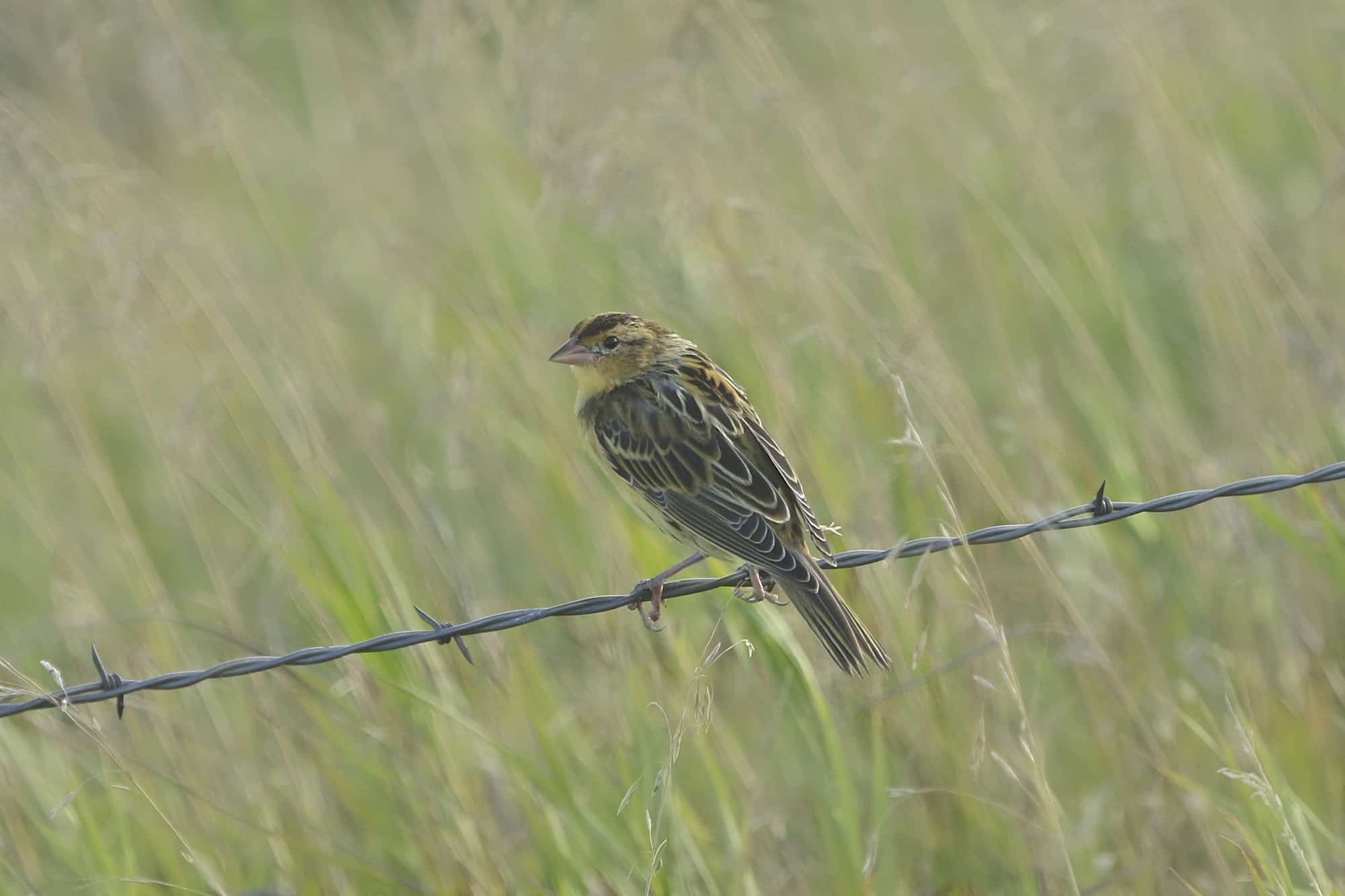
- Ammodramus leconteii
- Order: Passeriformes
- Family: Passerellidae
- Length: 4.3-5.1 inches (11-13 cm)
- Weight: 0.3-0.4 ounces (9-12 grams)
- Wingspan: 6.7-7.5 inches (17-19 cm)
The LeConte’s Sparrow is small with a short, rounded tail. Its coloring is a bit different from other sparrows: buff-colored face, pale grayish-brown on top, and reddish-brown streaks. The yellow wash over most of its body makes it stand out.
LeConte’s Sparrows breed in the far northern reaches of North America, and they spend the winter in the American southeast (but not as far as Florida). They migrate through South Dakota on their journey between these two areas. You are most likely to see them in wetlands.
They are named for the American entomologist John Lawrence LeConte–who named more than 5,000 species of beetles in his lifetime!
These sparrows are quite secretive and are very good at hiding themselves in the marshy wetlands where they live. This makes them a challenge for birders who are trying to identify as many sparrows as possible.
Lincoln’s Sparrow

- Melospiza lincolnii
- Order: Passeriformes
- Family: Passerellidae
- Length: 4.7-5.9 inches (12-15 cm)
- Weight: 0.4-0.6 ounces (12-17 grams)
- Wingspan: 7.9-8.7 inches (20-22 cm)
The little Lincoln’s Sparrow has a long tail, brown feathers, and dark streaks on its back. Its belly is pale gray, and it has a brown crown. Look for the buff eyestripe, too. When it raises its feathers on the back of its head, the Lincoln’s Sparrow can look crested.
They travel through South Dakota in the spring and fall. Although they are found throughout the entire state, you can generally find them near water sources like lakes, rivers, ponds, and wetlands. They forage on the ground and eat a diet made up of insects, spiders, and seeds.
Lincoln’s Sparrows have an appealing song that the Cornell Lab describes like this:
“Lincoln’s Sparrows are one of the most musical sparrows. Males sing a rich wrenlike song of trills, gurgles, and buzzes from exposed perches or tucked inside a shrub.
Each song starts off with 2 or 3 bell-like notes before bursting into bubbly trills and gurgles that rapidly change pitch. The song ends with a thin slurred trill as if the bird is running out of steam or perhaps running back into the willow thicket to hide. Each song lasts for about 2 seconds.”
Nelson’s Sparrow
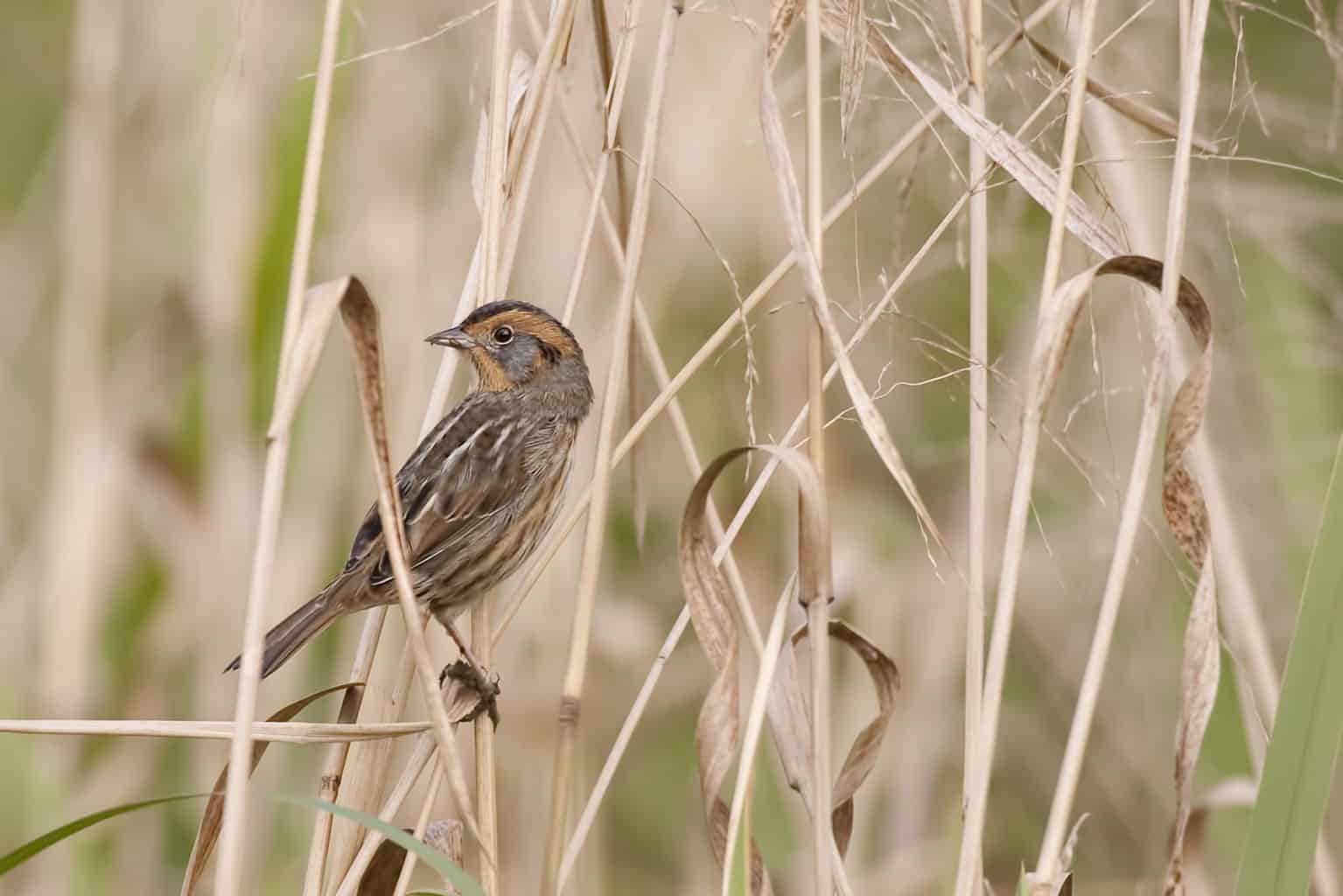
- Ammodramus nelsoni
- Order: Passeriformes
- Family: Passerellidae
- Length: 4.7-5.5 inches (12-14 cm)
- Weight: 0.4-0.6 ounces (12-17 grams)
- Wingspan: 6.7-7.9 inches (17-20 cm)
The darkly pigmented Nelson’s Sparrow is small and compact with a short tail. it has a gray face, pale eyebrows, and a dark eye line. Their coloring is mostly brownish-black with a pale gray underbelly.
Their main breeding territory stretches across Manitoba, Saskatchewan, and Alberta, Canada. When they migrate to the Atlantic and Gulf Coasts for the winter, they travel through the eastern half of South Dakota. Look for them in marshes and wetlands.
Nelson’s Sparrows don’t have a very big territorial range, especially in the winter. That makes them an especially desirable sighting for many birders. South Dakotans are lucky that they can watch out for them in the spring and fall.
Until 1998, Nelson’s Sparrows and Saltmarsh Sparrows were considered to be the same species–the Sharp-Tailed Sparrow. During the winter, both of these sparrows live together right along the coastline. They do not live inland during the winter months.
White-crowned Sparrow
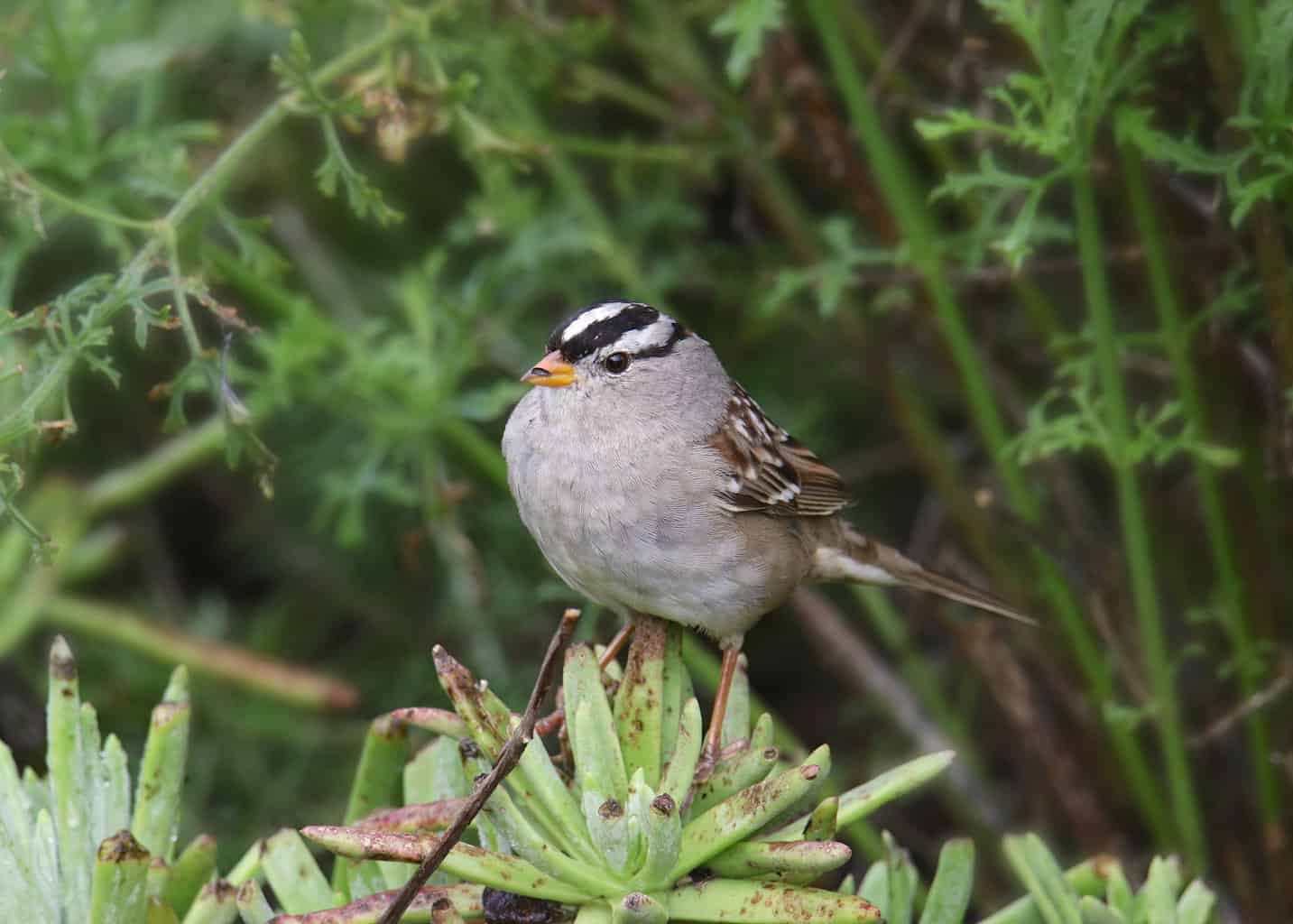
- Zonotrichia leucophrys
- Order: Passeriformes
- Family: Passerellidae
- Length: 6.3-7.9 inches (16-20 cm)
- Weight: 0.9-1.4 ounces (26-39 grams)
- Wingspan: 9.8-11.4 inches (25-29 cm)
The White-Crowned Sparrow has a plump body and a long tail. Its distinctive head pattern features black and white stripes. The rest of the bird is brownish-gray and pale gray, and white-crowned Sparrows may have a pink or yellow bill.
They migrate through South Dakota and are found in a variety of habitats, including shrubby areas and the edges of forests, grasslands, and gardens. Like other sparrows, they are ground foragers who scratch and peck about, looking for seeds, insects, and berries.
The very southeastern edge of South Dakota sometimes sees White-crowned Sparrows during the winter, too.
White-Crowned Sparrows are one of the easiest sparrows to recognize, thanks to those dramatic and contrasting black and white stripes on their heads.
The Final Word on Spotting Sparrows in South Dakota
When you realize just how many kinds of sparrows are present in South Dakota, it becomes a much more exciting challenge to try to spot them all!
Although some are incredibly widespread, like the House and Song Sparrows, others are more of a challenge, like the ones that migrate between summer and winter grounds.

